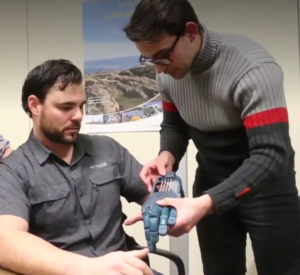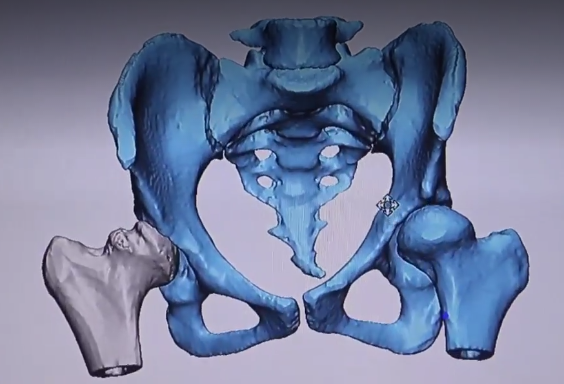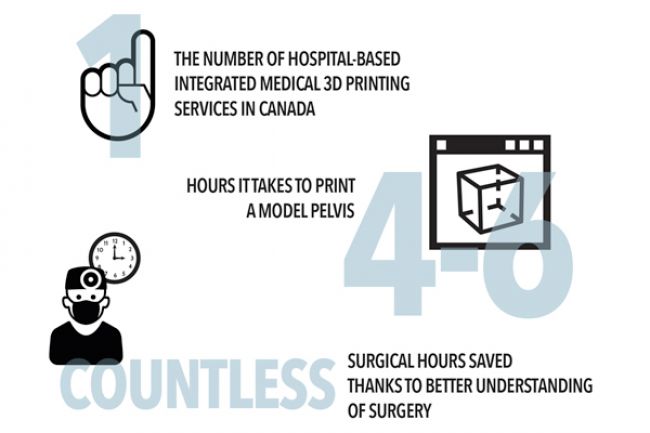 3D printing in the medical field can be found all over the world, from Dubai to Africa and from Ireland to the United States, and now to Canada as well. The Ottawa Hospital is the first hospital in Canada to institute an integrated 3D printing program, used for education, surgical planning, and research. The centerpiece of the program is the hospital’s new $400,000 Stratasys Connex3 printer, acquired through a generous donation, but in the future, the lab plans to add more printers that can 3D print using different materials, such as titanium, rubber, silicone, and human cells. Dr. Adnan Sheikh, medical director of the hospital’s 3D printing program, says that the medical 3D printing field continues to undergo rapid change, and that this is “what the future of medicine looks like,” though some argue that 3D printing is more specifically the future of surgery.
3D printing in the medical field can be found all over the world, from Dubai to Africa and from Ireland to the United States, and now to Canada as well. The Ottawa Hospital is the first hospital in Canada to institute an integrated 3D printing program, used for education, surgical planning, and research. The centerpiece of the program is the hospital’s new $400,000 Stratasys Connex3 printer, acquired through a generous donation, but in the future, the lab plans to add more printers that can 3D print using different materials, such as titanium, rubber, silicone, and human cells. Dr. Adnan Sheikh, medical director of the hospital’s 3D printing program, says that the medical 3D printing field continues to undergo rapid change, and that this is “what the future of medicine looks like,” though some argue that 3D printing is more specifically the future of surgery.
“This is an important and exciting step as we move forward with our vision of providing 21st-century care for the people of eastern Ontario. Our 3D Medical Printing Program opens the door to many exciting and innovative research opportunities, but most importantly it will improve the care we provide for our patients,” said Dr. Jack Kitts, President and CEO of The Ottawa Hospital.
 The 3D printing lab is already making headlines: the first patient to benefit from the program is 33-year-old Dave Chasse, who lost the majority of his left hand in a motorcycle accident in June 2015. He was knocked off of his motorcycle on the highway by a van, and had four digits torn right from his hand. But this week, Chasse was fitted with a movable, flexible 3D printed hand, which allows him to bend his fingers and pick up small objects.
The 3D printing lab is already making headlines: the first patient to benefit from the program is 33-year-old Dave Chasse, who lost the majority of his left hand in a motorcycle accident in June 2015. He was knocked off of his motorcycle on the highway by a van, and had four digits torn right from his hand. But this week, Chasse was fitted with a movable, flexible 3D printed hand, which allows him to bend his fingers and pick up small objects.
Chasse said, “It’s overwhelming: It’s as if I have fingers again.”
The computer-designed device is wrist-activated, and fits on top of his palm and right next to his thumb, the only parts of his hand that were able to be saved after the accident.
Dr. Sheikh said, “In a 3D printing lab, it’s much easier and much faster to make this kind of prosthetic. We just take the measurements, run it through a CAT (computer assisted tomography) program, and we print it.”
Take a look at this Montreal Gazette video to learn more about Chasse’s new 3D printed prosthetic hand.
 3D printing prosthetic hands will not be the only application for The Ottawa Hospital’s 3D printing program; it will also create detailed 3D anatomical models to help surgeons get ready for complex procedures and operations. The 3D models are printed from computer-processed radiologic images, and will be able to show surgeons, for example, the exact shape of a tumor, and where it’s located in relation to nearby muscles, blood vessels, and bones. Using these detailed 3D models in the surgical planning process can cut down on surgical errors, and can also be used to educate patients and train medical students.
3D printing prosthetic hands will not be the only application for The Ottawa Hospital’s 3D printing program; it will also create detailed 3D anatomical models to help surgeons get ready for complex procedures and operations. The 3D models are printed from computer-processed radiologic images, and will be able to show surgeons, for example, the exact shape of a tumor, and where it’s located in relation to nearby muscles, blood vessels, and bones. Using these detailed 3D models in the surgical planning process can cut down on surgical errors, and can also be used to educate patients and train medical students.
Dr. Frank Rybicki, 3D medical printing pioneer and chief of medical imaging at The Ottawa Hospital, said, “There’s no better way to learn anatomy than to hold it and spin it around in your hands.”
The program will also be able to help fracture patients, patients suffering from cancer, patients with skull-based tumors, and vascular and orthopaedic patients. Dr. Rybicki, who was part of the 2011 Boston-based medical team responsible for planning and conducting the first facial transplant in North America with 3D printing, said that the program will help the hospital “join a medical revolution.”
When asked about the hospital’s new 3D printer, Dr. Rybicki said, “Think of this as the first cell phone. It’s going to get smaller, less expensive, more powerful, but the concept will be the same.”
The 3D printing program will also open up new avenues of research for the hospital. Dr. Rybicki, who has only been with The Ottawa Hospital for 18 months, is leading the 3D printing charge for a new chapter in radiology history, which began in 1896 with the birth of the X-ray.
Dr. Rybicki explained, “One of the things I was charged to do was advance my department, and the institution as a whole. Having a 3D printing program puts Medical Imaging at the center of radiology’s international stage, moves us closer to becoming a top 10 per cent hospital in North America, and it enables Tender Loving Research by bringing new technologies to Ottawa and the region. 3D printing is the fastest growing technology in the medical sector today, with multidisciplinary opportunities as the field evolves before us.”
Dr. Sheikh explained that the hospital’s 3D printer, and its 3D printing program as a whole, can help answer important surgical questions, like what the best surgical approach is in a rare case, such as an aggressive tumor that’s completely eroded a pelvic bone down to the joint. What is the relationship between the surrounding blood vessels and the tumor? Detailed 3D printed models give doctors a way to plan and practice for complex reconstructive surgeries, which in turn gives them confidence and clarity. In the case of the pelvic tumor, a 3D replica of the damaged bone can be created and 3D printed, while a second model, printed to scale, can show the surgeon precisely where to make incisions.
He also said that each hour spent in the OR costs the hospital between three and four thousand dollars, so less time spent operating saves money, and can result in fewer complications.Dr. Sheikh said, “Even a millimetre here or there makes a difference.”
“You know exactly what you’re doing. That really cuts down the morbidity and any complications relating to any complex procedure.”
Looking ahead to the future of the 3D printing program at The Ottawa Hospital, they hope to acquire a 3D printer that can create customized human implants, as soon as they are able to get the necessary funding for it. Dr. Sheikh is also excited about the possibility of 3D printed organs.
“The U.S. has already spent billions of dollars for research on organ printing and we would love to take the initiative,” said Dr. Sheikh. “We have the leadership and the expertise here. That’s our aim. That’s going to change everything. What we are doing right now is really just the tip of the iceberg. 3D printing is revolutionizing the way we practice medicine, now, and 10 years from now.”
Discuss in the Ottawa Hospital forum at 3DPB.com.
[Sources: Ottawa Business Journal / Montreal Gazette]
Subscribe to Our Email Newsletter
Stay up-to-date on all the latest news from the 3D printing industry and receive information and offers from third party vendors.
Print Services
Upload your 3D Models and get them printed quickly and efficiently.
You May Also Like
Reinventing Reindustrialization: Why NAVWAR Project Manager Spencer Koroly Invented a Made-in-America 3D Printer
It has become virtually impossible to regularly follow additive manufacturing (AM) industry news and not stumble across the term “defense industrial base” (DIB), a concept encompassing all the many diverse...
Inside The Barnes Global Advisors’ Vision for a Stronger AM Ecosystem
As additive manufacturing (AM) continues to revolutionize the industrial landscape, Pittsburgh-based consultancy The Barnes Global Advisors (TBGA) is helping shape what that future looks like. As the largest independent AM...
Ruggedized: How USMC Innovation Officer Matt Pine Navigates 3D Printing in the Military
Disclaimer: Matt Pine’s views are not the views of the Department of Defense nor the U.S. Marine Corps Throughout this decade thus far, the military’s adoption of additive manufacturing (AM)...
U.S. Congress Calls Out 3D Printing in Proposal for Commercial Reserve Manufacturing Network
Last week, the U.S. House of Representatives’ Appropriations Committee moved the FY 2026 defense bill forward to the House floor. Included in the legislation is a $131 million proposal for...


![Dr. Frank Rybicki, the new chief of medical imaging at The Ottawa Hospital and a leading expert in 3D printing for medical use, demonstrated how a 3D model can show the spatial relationship between a tumour and major blood vessels. [Image: The Ottawa Hospital]](https://3dprint.com/wp-content/uploads/2017/02/Dr-Frank-Rybicki-Ottawa-Hospital-300x260.jpg)
![L-R: Dr. Sheikh and Dr. Rybicki [Image: The Ottawa Hospital]](https://3dprint.com/wp-content/uploads/2017/02/Drs-Sheikh_Rybicki-Ottawa.jpg)
































